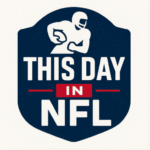The Baugh/Marshall Rule Is Born: A Championship Decided by a Goal Post
On December 16, 1945 The 1945 NFL Championship between the Washington Redskins and Cleveland Rams began with one of the strangest plays in football history. Early in the first quarter, Redskins quarterback Sammy Baugh, playing in his fifth title game, dropped back into his own end zone and fired a pass—only for it to hit the goal post, which at the time stood on the goal line. The ball bounced back to the turf for a safety, giving the Rams an early 2–0 lead.
Baugh later left the game with bruised ribs, but his backup Frank Filchock kept Washington in it, throwing touchdowns to Steve Bagarus and Bob Seymour. Rookie quarterback Bob Waterfield countered for Cleveland, tossing two long touchdown passes, including a 44-yard strike to Jim Gillette. Despite Washington’s rally, two missed field goals in the fourth quarter sealed their fate, as the Rams held on for a 15–14 victory.
That odd first-quarter safety turned out to be the difference—and it sparked a major change. Furious at the outcome, Redskins owner George Preston Marshall pushed for a new rule making any pass that hit the goal post automatically incomplete. It became known as the Baugh/Marshall Rule, lasting until 1974 when the goal posts were moved to the back of the end zone, ending one of football’s quirkiest chapters.

